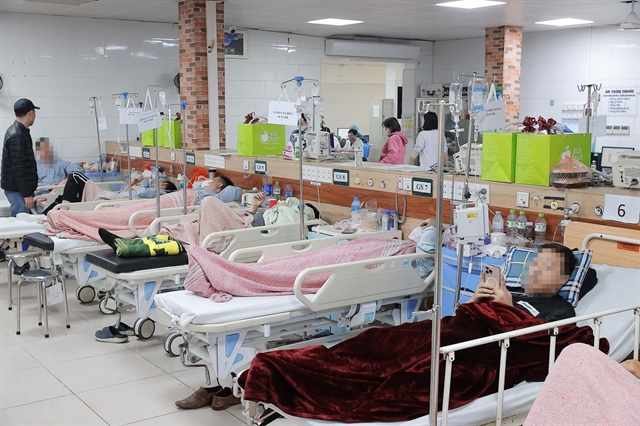 Society
Society

 |
| Patients in the most recent poisoning case occurred on December 19 in Long Biên District, Hà Nội, are treated at Bạch Mai Hospital's Poison Control Centre. — VNA/VNS Photo Minh Quyết |
HÀ NỘI — Việt Nam has recorded 131 food poisoning incidents, affecting 4,796 people and resulting in 21 deaths in the first 11 months of this year.
Compared to the same period last year, the number of incidents has increased by seven and the number of people affected has risen by 2,677, although the death toll has gone down by seven.
Of the total number of incidents, 29 were classified as large-scale (involving 30 or more people), leading to 4,049 people falling ill and two fatalities.
Smaller or medium-scale incidents (affecting fewer than 30 people) totalled 102, with 747 affected, resulting in 19 deaths.
According to the Ministry of Health, of the 131 reported food poisoning cases, 43 were linked to natural toxins (mainly from toads, wild mushrooms, mangrove horseshoe crabs, pufferfish, and unfamiliar crabs), six involved chemicals, 45 were caused by microorganisms, and 37 remain under investigation.
Over the past year, there have been several food poisoning outbreaks in communal kitchens, notably in companies in Vĩnh Phúc and Đồng Nai provinces, and in school cafeterias, canteens and food establishments near schools in Khánh Hòa Province and HCM City as well as incidents involving street food in the provinces of Khánh Hòa, Đồng Nai and Sóc Trăng.
This month, a number of collective food poisoning cases have been reported, resulting in hospitalisations and even deaths.
The most recent case occurred on December 19 in Long Biên District, Hà Nội, in which two people died and several others were hospitalised.
As of Tuesday morning, among the 20 patients admitted, many remained in serious condition.
Of the 18 patients treated at Bach Mai Hospital, four were discharged after stabilising, while 14 others were diagnosed with septic shock and metabolic acidosis, with five in critical condition currently receiving intensive treatment.
Authorities have identified the cause of the poisoning as the presence of acetonitrile, a chemical found in white alcohol consumed during a party.
On December 22, Vũng Tàu Hospital in Bà Rịa – Vũng Tàu Province received four patients with suspected methanol poisoning after consuming alcohol.
After intensive treatment, three patients stabilised, while a 24-year-old patient remained in a coma and was in critical condition. Before hospitalisation, the 24-year-old patient had called for a home infusion, but after nearly finishing the infusion, he exhibited signs of shock, seizures and stiffening of the body.
Earlier this month, over 40 workers from a fashion company located in the WHA Industrial Zone in Nghi Thuận, Nghi Lộc District in Nghệ An Province, were hospitalised with symptoms including dizziness, headaches, nausea, and flushing. Some reported chest tightness and rashes.
The initial diagnosis was food poisoning and grade 1 anaphylaxis.
The patients were treated with intravenous fluids, antihistamines, and corticosteroids. Fortunately, all of them have stabilised.
Enhancing inspections
In response to the complexity of food poisoning cases, especially in company canteens, schools and street food, the health ministry has advised the Prime Minister to issue a directive on strengthening efforts to prevent and address food poisoning.
Throughout the year, food safety inspections have been intensified and violations have been dealt with severely.
By November 30, health authorities at both central and local levels had inspected 354,820 establishments, identifying 22,073 violations (6.22 per cent of the total inspected). A total of 9,043 facilities have been penalised.
The ministry also reported on the surveillance activities of 40 food safety management agencies across various provinces and cities.
In total, 18,082 samples were tested, with 526 failing to meet standards (2.9 per cent). Additionally, six institutes under the ministry tested 387 samples, with 13 (about 3.3 per cent) failing to meet standards.
The food safety testing system has been upgraded, and six laboratories at central institutes and 63 provincial food testing facilities are now accredited to ISO/IEC 17025 standards.
The ministry has designated 16 laboratories to serve State management needs, bringing the total number of designated food testing facilities to 40. All are still operational.
In 2025, the ministry plans to continue improving the regulatory framework for food safety, reviewing and refining the Law on Food Safety and relevant decrees.
Along with bolstering communication efforts, the ministry will also continue to implement the Politburo's Directive No. 17-CT/TW, which strengthens food safety and security, particularly by proposing models for unified food safety management from the central government down to local levels.— VNS




